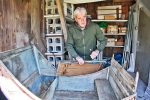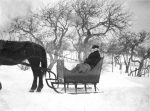 A rare early 19th century horse-drawn sleigh is being restored to its former splendor in Sandwich, Massachusetts. The Portland Cutter sleigh, built in the early 1800s, has spent untold years in obscurity in a broken-down shed at Meadow Spring Farm. It was rediscovered by John Nye Cullity, executive director of the Nye Family Association, when the farm was set to go on sale in 1997. It was derelict, only the bottom of it intact, the rest in pieces. Cullity rescued it and kept it safe, but he didn’t have the first idea how to to go about putting it back together.
A rare early 19th century horse-drawn sleigh is being restored to its former splendor in Sandwich, Massachusetts. The Portland Cutter sleigh, built in the early 1800s, has spent untold years in obscurity in a broken-down shed at Meadow Spring Farm. It was rediscovered by John Nye Cullity, executive director of the Nye Family Association, when the farm was set to go on sale in 1997. It was derelict, only the bottom of it intact, the rest in pieces. Cullity rescued it and kept it safe, but he didn’t have the first idea how to to go about putting it back together.
Former boatbuilder and current historical archaeologist David Wheelock found out about the sleigh while doing some repairs to a grist mill next to the Benjamin Nye Homestead and Museum which is managed by the Nye Family Association. He offered to restore the sleigh.
When the sleigh was collected from the crumbling farm site, its pieces were so covered in animal feces and cobwebs that they looked black, and there was some debate as to whether the sleigh was salvageable.
Undeterred, Mr. Wheelock spread everything he could find of the sleigh, including one of the four wooden wedges used to hold the convertible top on, upon the lawn and spent a day with a scrub brush and pail of soapy water, cleaning each piece.
When the scrubbing was finished, he could see the sleigh’s original colors of red, blue, blue/green, and black.
Mr. Wheelock then reassembled the sleigh. He noticed a black, oily substance under the driver’s bench and realized it was tallow stains from years of the drivers’ boots rubbing against the wood. Tallow was once used as waterproofing grease.
These historic tallow stains will be left untouched when he repaints the rest of the sleigh, he said.
A Portland Cutter was a light sleigh with a square body shape, flat body panels and a dash designed to protect riders from the wind and snow kicked up by the horse. That dash started out flat but later evolved a curved shape The original designer is believed to be Peter Kimball, a carriage maker in Portland, Maine, but their speed and maneuverability made them the most popular form in the country and many manufacturers, particularly in New England, Michigan and Wisconsin, sold models of Portland Cutters all over the country.
Drawn by one horse, the cutter was the most convenient conveyance in snowy climes before the automobile blew all horse-drawn vehicles off the road. Carriages could not negotiate snow-covered roads anywhere near as well. People would take the trotters that drew their carriages when the ground was passable and hitch them up to the sleigh the same way we switch out our regular tires with snow tires today.
A certain song you may have heard once or twice (ie, ad nauseum), written by James Pierport and published in 1857 as “One Horse Open Sleigh,” now known as “Jingle Bells,” was inspired by the Portland Cutter. The bells were necessary, in some places even legally required, because the horses’ hooves were muffled by snow and the sleighs’ runners so quiet that they often caused traffic accidents. The bells on the horse’s harness were an alert system. The sleighs were open, with no roof or enclosure to protect the riders from the cold of winter (hence the song). People kept warm under blankets, or by putting a metal box of hot coals on the floor of the sleigh and using it as a toasty footrest.
The cutters were so fast (“dashing through the snow” wasn’t a euphemism) that sleigh racing became a fashionable winter sport and going to watch the sleigh races a popular pastime. Henry Wadsworth Longfellow wrote about attending the sleigh races in his diary.
So they were road hard and put away wet (for once that idiom can be used literally), and early models are very hard to find in any condition at all. That’s why an early 19th century model is a major discovery, and why it’s worth all the hard work necessary to put one back together.
 Wheelock believes that 80% of the original parts can be used in the restoration, wood panels, the original wooden pegs, hand-cut nuts and bolts, the wrought iron braces, all but the bottom of the iron runners. The runners will be photographed and documented so that their precise curve can be recreated after they’re removed from the sleigh because as soon as they’re no longer bearing weight, the curves will release.
Wheelock believes that 80% of the original parts can be used in the restoration, wood panels, the original wooden pegs, hand-cut nuts and bolts, the wrought iron braces, all but the bottom of the iron runners. The runners will be photographed and documented so that their precise curve can be recreated after they’re removed from the sleigh because as soon as they’re no longer bearing weight, the curves will release.
 By a great stroke of history nerd luck, Mr. Cullity is in possession of a photograph shot around 1900 of his great-great-grandfather Robert Armstrong riding in that sleigh, blanket on his lap, in the snow-covered wilds of Route 6A in Sandwich. That means the sleigh put in at least a century of service. The picture is also invaluable to Wheelock’s restoration since it shows the sleigh intact and in use.
By a great stroke of history nerd luck, Mr. Cullity is in possession of a photograph shot around 1900 of his great-great-grandfather Robert Armstrong riding in that sleigh, blanket on his lap, in the snow-covered wilds of Route 6A in Sandwich. That means the sleigh put in at least a century of service. The picture is also invaluable to Wheelock’s restoration since it shows the sleigh intact and in use.
 The Nye family will be involved in the restoration in another way too. White oak boards that were cut into planks by Cullity’s grandfather 100 years ago will be used to make new runners and braces for the sleigh.
The Nye family will be involved in the restoration in another way too. White oak boards that were cut into planks by Cullity’s grandfather 100 years ago will be used to make new runners and braces for the sleigh.
The restoration should be complete by mid-June, in time for it to go on display at the Nye Homestead when it reopens for the season.